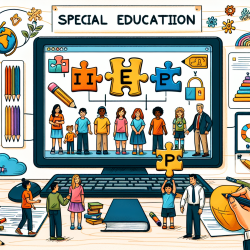Introduction
In the ever-evolving field of speech-language pathology, understanding the neural underpinnings of language and visual perception is crucial for enhancing therapeutic outcomes. The research article titled "Language and Visual Perception Associations: Meta-Analytic Connectivity Modeling of Brodmann Area 37" provides valuable insights into the connectivity of Brodmann Area 37 (BA37) and its role in language and visual processing. This blog will explore the implications of these findings for practitioners, emphasizing data-driven strategies to improve outcomes for children.
The Role of Brodmann Area 37
BA37, located in the posterior, inferior, and temporal/fusiform gyrus, is a pivotal node in two distinct networks: one for visual recognition and the other for semantic language functions. The research conducted by Ardila, Bernal, and Rosselli (2015) highlights that BA37 is not isolated in its function but is part of a complex network that integrates visual and linguistic information. This dual role underscores the importance of BA37 in both oral and written language processing, as well as in visual perception.
Implications for Practitioners
For speech-language pathologists, these findings offer a framework for developing interventions that leverage the connectivity of BA37. Here are some practical applications:
- Integrated Language and Visual Therapy: Given BA37's role in linking visual and auditory information, practitioners can design activities that simultaneously engage visual and language skills. For example, using picture books that require children to name objects and describe scenes can strengthen both networks.
- Targeted Language Interventions: Understanding that BA37 is involved in semantic categorization and word retrieval can guide therapists in creating targeted language exercises that focus on these areas. Activities like semantic mapping and word association games can be particularly beneficial.
- Visual Perception Enhancement: Since BA37 is also involved in visual processing, incorporating visual-spatial tasks such as puzzles and visual memory games can enhance cognitive flexibility and support language development.
Encouraging Further Research
While the study provides a robust model of BA37's connectivity, it also opens avenues for further research. Practitioners are encouraged to explore how these findings can be applied to diverse populations, including bilingual children and those with specific language impairments. Additionally, investigating the impact of targeted interventions on BA37's connectivity could yield valuable insights into optimizing therapy outcomes.
Conclusion
The meta-analytic connectivity modeling of BA37 offers a comprehensive view of its role in language and visual perception. By integrating these findings into practice, speech-language pathologists can enhance their therapeutic approaches, ultimately leading to better outcomes for children. For those interested in delving deeper into the research, the original paper provides a detailed exploration of BA37's connectivity and its implications.
To read the original research paper, please follow this link: Language and Visual Perception Associations: Meta-Analytic Connectivity Modeling of Brodmann Area 37.










